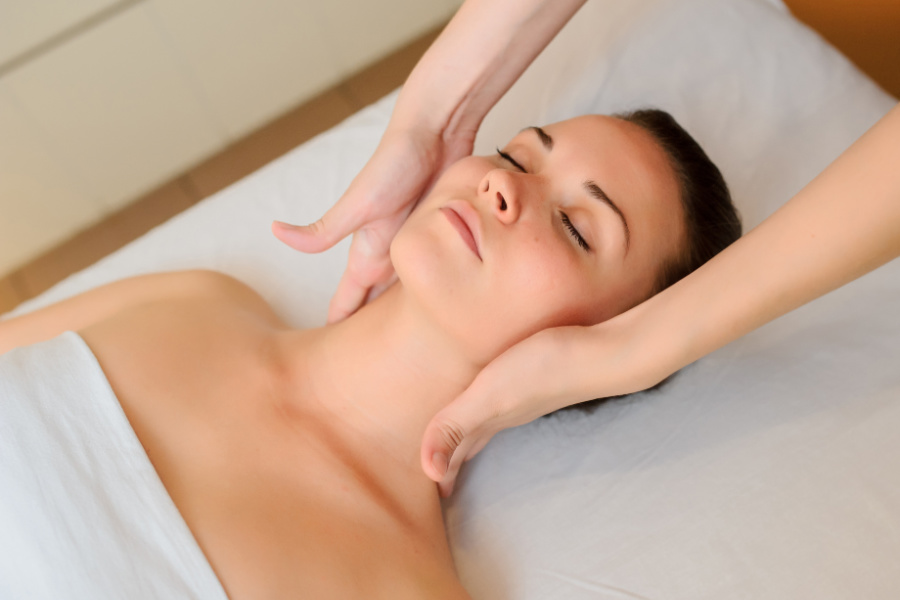
The lymphatic system plays a vital role in supporting your immune health. It consists of a complex network of lymph nodes that transport lymph fluid back into your bloodstream. Along the way, it removes waste, toxins, and carries white blood cells that help your body fight off infection.
When the lymphatic system becomes sluggish or blocked, fluid can accumulate, leading to puffiness and swelling. This is where lymphatic drainage—a specialized form of massage—can help.
Originally developed to manage lymphedema, a condition involving chronic swelling often seen after lymph node removal, lymphatic drainage has gained popularity in the beauty world.
In recent years, facial lymphatic drainage has become a go-to for those seeking to reduce puffiness, calm skin irritation, and brighten a tired-looking complexion. Some even refer to it as a "nonsurgical facelift."
But does it really deliver on all the claims? While many people swear by its benefits, scientific evidence is still limited. Keep reading to discover what facial lymphatic drainage can—and can’t—do for your skin.
Lymphatic drainage treatments help speed up the absorption and movement of lymph fluid, which carries toxins, bacteria, viruses, and proteins through the body. This boost to the lymphatic system has been shown to provide medical benefits, particularly for those with conditions like lymphedema or other lymphatic disorders.
It may also aid in reducing post-surgical swelling. For example, a 2007 study found that lymphatic drainage was effective in minimising swelling after wisdom tooth removal.
Beyond medical conditions, this type of treatment may offer support for skin concerns such as acne and eczema, as well as digestive issues—thanks to its role in reducing inflammation and promoting detoxification.

Lymphatic drainage has gained popularity in the beauty world, with claims that it can reduce puffiness, smooth fine lines, minimise under-eye bags, and even firm sagging skin. While the treatment is often praised for delivering a refreshed, sculpted appearance, scientific research on its cosmetic benefits remains limited.
Some evidence suggests a link between lymphatic function and skin appearance. A 2015 study conducted by a Japanese research team, in partnership with a beauty brand, identified a connection between reduced lymphatic activity in the skin and sagging. However, their solution focused on topical ingredients rather than manual drainage techniques.
Other research has explored lymphatic drainage more directly. A 2010 study found that body lymphatic drainage helped reduce thigh circumference and fat thickness in individuals with cellulite, suggesting possible firming effects. While promising, the study was small, and more robust research is needed.
A 2012 announcement by Australian researchers indicated a potential benefit for the eye area, though results from that study have not yet been published.
Expert opinions remain divided. Some dermatologists question whether facial lymphatic stagnation is a concern for the general population. Others acknowledge that aging and sun damage may reduce lymphatic function in the skin, and stimulating lymph flow might support fluid reduction—though it's unclear whether facial massage alone can achieve this.
In short, while lymphatic drainage may help enhance the look and feel of the skin, its cosmetic benefits are largely anecdotal and not yet strongly supported by clinical research. Still, many individuals report feeling refreshed and glowing after a session, which may be reason enough to enjoy it as part of a skincare routine.
Lymphatic drainage is typically performed by a trained professional. If you're seeking the treatment for aesthetic purposes, look for a qualified aesthetician or skincare therapist with experience in manual lymphatic drainage techniques.
For medical concerns, it’s best to consult a specialist with appropriate training in lymphatic therapy, such as a certified lymphoedema practitioner.
The treatment involves gentle, rhythmic movements such as tapping, stroking, rubbing, and light pressure. Using flat hands and soft finger movements, the therapist will stretch and guide the skin in the direction of lymph flow to help encourage natural drainage.
A lymphatic drainage facial follows similar techniques but is focused on the face and neck. It may also include soft brushing motions and light sculpting to reduce puffiness and improve tone.
A full-body lymphatic drainage session usually lasts around an hour, while a facial version is typically shorter. Deep breathing exercises are often incorporated to help stimulate the lymphatic system and enhance the results of the treatment.
.jpg)
If you're unsure whether a professional lymphatic drainage facial is right for you, the good news is that you can try a simplified version at home—completely free of charge.
You can perform this routine daily or a few times a week—whatever suits your schedule. If you're unsure about the technique or want to get it just right, consider asking a trained skincare therapist or aesthetician for guidance.
Lymphatic drainage is generally considered safe for most people. However, it's important to speak to your healthcare provider before trying it—especially if you have any of the following conditions:
Always seek professional advice to ensure the treatment is appropriate for your individual health needs.
Lymphatic drainage is a well-established therapy for medical conditions involving swelling or poor lymphatic function. While its cosmetic benefits—like firmer skin or reduced puffiness—are promising, more scientific evidence is needed to fully support these claims.
It may not be a miracle alternative to a surgical facelift, but it’s generally safe and gentle. If you're curious, it could be worth exploring—either through a professional treatment or a simple DIY routine at home.
Booking a course can be a cost-effective option if you're looking to maximise results over multiple sessions.
